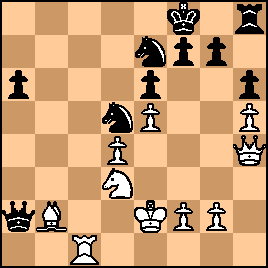| Aug-25-03 | | Brian Watson: If 13...Qxa1, 14.Bxh6 Qxh1 15.Qxg7+ Ke8 16.Qxh8+ . . . but then what? I'm not seeing why white can allow the Qc3+ fork. Also, is black still lost if he plays something other than 27...Nbd5? |
|
| Aug-25-03 | | Jonber: White can afford to allow the queen fork because material in chess is, to paraphrase, only on side of the coin. Equally important are factors like piece activity, initiative and passed pawns. Following the line you propose: 13...Qxa1 14.Bxh6 Qxh1 15.Qxg7+ Ke8 16.Qxh8+ Kd7 17.Bg5 Nbc6 18.Bxe7 Nxe7 19.Bb5+ Kc7 20.Qe8 Nf5 21.g4  Black is up a rook to two pawns, but almost all of Black’s pieces are tied down or lost on the wrong side of the board. White, however, has his, or her as it is, pieces active, with the queen and bishop bearing down on Black’s badly placed king, and a powerful, protected passed pawn emerging on h-file. Obviously, the mainline offers Black better opportunities. As you point out, Black certainly wouldn’t be lost if he had played something else then 27...Nbd5, which simply was a blunder. After for instance 27…Qd5 the game looks fairly equal. |
|
Jun-29-05
 | | samvega: Actually, I think black is in a tough spot:
27..Qd5 28.Rc7 Qd8 29.Rxe7 Qxe7 30.Ba3
or 28..Nc6 29.Rxc6 Nxc6 30.Qd8+ etc
or 28..Nbc8 29.Ke3, threatening Ba3.
Anyway, another cool Polgar Winawer. |
|
| Aug-31-05 | | Anastasia: yeah well what about 27..qd5 28.rc7 nf5, smarty pants |
|
| Sep-03-05 | | Brian Watson: Has <Jonber> left permanently? Haven't looked at this for a long time.. After 27..Qd5, black's rook is still hemmed in and white still has a space advantage. Doesn't there have to be a way for white to win? |
|
| Sep-04-05 | | rdwsusanto: <jonber> in your lines. after 21.g4...., Black forced draw with 21... Nxd4+! 22.Nxd4 Qe4+! 23. Kf1 Qh1+ perpetual, because white can't allowed 23.Kd2 (or Kd1) Qxd4+  |
|
Oct-23-05
 | | samvega: <anastasia> <yeah well what about 27..qd5 28.rc7 nf5, smarty pants> What's so special about Nf5?? 27..Qd5 28.Rc7 Nf5 29.Qf4, and white pushes the g pawn. If 29..Qxg2?, 30.d5. |
|
| Jan-01-06 | | Jonber: <Brian Watson> Nay, I haven't left permanently, I still stop by from time to time. Thank you for wondering, and sorry that it's been awhile since I looked at this game. <Rdwsusanto> You are absolutely right. Nice catch, I should have seen that. And if Black elects to take the knight without check by 23…Qxd4, then it's White who forces the draw with 24.Qe7+ Kb8 25.Qd6+ Kb7. So it stands to reason, the mainline (Ba6) does offer better chances. <Samvega> After 27...Qd5 28.Rc7 Nf5 29.Qf4 Qxg2 30.d5? Nxd5 forks the queen and rook. White can save both pieces with 31.Rc8+ Ke7 32.Qc4 Rxc8 33.Qxc8 but this solves Black's rook problem and leaves him two pawns up. I think White's best after 29...Qxg2 is just 30.Qf3 Qxf3+ 31.Kxf3 and an equal endgame would ensue. White can keep the pawn on g2 though, playing 29.Qg4 instead: 29.Qg4 Kg8 (heading for h7, eventually) 30.Qf3 Qa2 31.Kf1 (Black threatens Na4, so the pin must be resolved forthwith) Nd5 32.Rb7 and I suppose White has a small advantage. As Mr. Watson points out, the Black rook is hemmed in; White has a space advantage and Black's pawn on the a-file seems weak. However, Black's knight's looks strong, even with g4 coming, White's king looks a little bit exposed, and the rook can come to life, either by along the eight rank after Kh7 or by playing g6. Given the pick I would choice White, but Black is by no means lost. |
|
| Jun-11-07 | | prinsallan: Judit with the winawer is always stunning to see. |
|
Aug-25-23
 | | WTHarvey: White mates in 2 (clearance).

click for larger view28. ? |
|
|
|
|





































